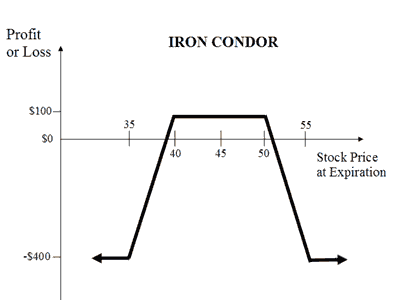
Timing
Some investors believe they have a ‘feel’ for the market, or individual stocks and ‘know’ when that stock is going to make a large move. If you are one of them, then don’t open an iron condor position unless you believe the stock is NOT going to make such a move before the options expire. As an alternative you can have an iron condor position with a bullish or bearish bias. You do that by choosing appropriate strike prices for the options spreads you choose.
Many investors (that includes me) cannot predict the future and are willing to own positions that profit when the market holds steady, trades within a range that’s not too wide, or if the market does move significantly in one direction, does so at a slow and steady pace.
Underlying
It’s generally safer to trade iron condors on indexes because you never have to be concerned with a single stock issuing unexpected news that results in a gap of 20% or more. True that can happen with an index if there is world-shattering news – but it’s a much less likely event.
Most indexes in the U.S. are European style vs. American style. That means they cannot be exercised before expiration – and that’s to your advantage. We’ll discuss the differences between these option ‘styles’ another day.
Expiration Month
Most iron condor traders prefer to have positions that expire in the front month (options with the least time remaining before they expire). These options have the most rapid time decay, and when you are a seller of option premium (when you collect cash for your positions as opposed to paying cash), the passage of time is your ally and rapid time decay is a positive attribute for your position.
However, there are negative factors associated with front-month options:
- With less time remaining, iron condor positions are worth less than if there were more time remaining. Thus, you collect less cash when you open the position.
- If the index undergoes a substantial price change, the rate at which money is lost is significantly greater when you have a front-month option position. It’s too early in your education to discuss why this is true in detail, but it’s because they gain or lose value more rapidly than options with longer lifetimes. This is effect of gamma, one of the ‘Greeks’ used to quantify risk when trading options. Because there are so many topics to discuss, I will not be getting to the Greeks for quite awhile.
- When you sell options that expire in the 2nd or 3rd month, you collect higher cash premiums (good), have positions that lose less when something bad happens (good), but there is more time for something bad to happen (bad). When you have iron condor positions, you don’t want to see something bad (and that’s a big market move). The more time remaining before the options expire, the greater the chance that something bad happens. That’s why traders who sell* iron condors are willing to pay you a higher price for them.
Strike Prices and Premium Collected
Choosing the strike prices for your iron condor position – and deciding how much cash credit you are willing to accept for taking on the risk involved – are irrevocably linked. Thus, I’ll discuss them together.
Assume the call spread and put spread are each 10-points wide.
For example: (RUT is the (Russell 2000 index)
- Sell 10 RUT Sep 620 put
- Buy 10 RUT Sep 610 put
- Sell 10 RUT Sep 760 call
- Buy 10 RUT Sep 770 call

If you are not a member yet, you can join our forum discussions for answers to all your options questions.
Market bias
Most of the time that you open an iron condor, you have a neutral opinion, i.e., you have no expectation that the stock is going to move in one direction as opposed to the other. As a result, you tend to choose a call spread and a put spread that are equally out of the money. To put it simply – the call and put you sell will each be approximately the same number of points away from the price of the underlying security. In our example above, If RUT is trading near 690, the 620 put and the 760 call are each 70 points out of the money, and the position is ‘distance neutral.’
There are other methods you can use to have a position that is ‘neutral.’ Instead of equally far out of the money, you may choose to sell spreads that bring in the same amount of cash. This is ‘dollar neutral,’ a method seldom used.
If you understand the term delta (we’ll get to it eventually) you may choose to sell spreads with equal delta. I don’t recommend this method for iron condors, although ‘delta neutral’ trading has a great deal to recommend it under different circumstances.
If you are bullish, you can choose to sell put spreads that bring in more cash, attempting to profit if the stock or index does move higher, per your expectation. If you are bearish, you can choose to sell call spreads that bring in more cash, attempting to profit if the stock or index does move lower, per your expectation.
How far out of the money
Most investors believe that the further out of the money the options they sell, the ‘safer’ their position and the less risk they have. That's one way to look at ‘safety.’
Probability vs. Maximum loss. If you sell the RUT 580/590 put spread instead of the 610/620 put spread, there is a higher probability that the options you sell will expire worthless, allowing you to earn the maximum profit that trading this iron condor allows.
I believe that is intuitively obvious, but for those who don’t see it, consider this (and for the purposes of this discussion, assume you hold this position until the options expire): Most of the time the options expire worthless, but part of the time, RUT moves far enough below 620, resulting in a loss. Part of the time that RUT is below 620 at expiration, it is also below 590. But, the probability that it’s below 590 must be less than the probability that it’s below 620 because part of the time RUT is going to be between 590 and 620. Thus, you lose money less often, when you sell options that are further out of the money. That fits the first definition of ‘safer’.
But, you can also look at it this way. When you sell the 580/590 put spread, you collect less cash than when you sell the 610/620 put spread. This is always true: the more distant the options are from the market price of the underlying stock or index, the less premium you collect when selling single options or option spreads.
This is why it’s so important to find your comfort zone when choosing the options that make up your iron condor.
-
You can trade options that are very far out of the money. These positions have a very small chance of losing money. You can easily find iron condors with a 90% (or even higher) probability of being winners. However, the cash you collect may be too little to make the trade worthwhile. Some investors are willing to sell iron condors and collect between $0.25 and $0.50 for each spread, netting them $50 to $100 per iron condor. If that makes you comfortable, then it’s okay for you to trade this way. For my taste, the monetary reward is too small. NOTE: Selling a spread for $0.40 translates into $40 cash, and the possibility of losing $960. Remember that the maximum loss is very high, and one giant loss can wipe out years of gains. The maximum loss is $950 per iron condor, when you only collect $50 to initiate the trade.
-
You can trade options that are far out of the money, but not so far that the premium you collect is too small. You still have a high probability of owning a winning position. You have the potential to earn more money because you collected more cash upfront. The maximum loss is reduced, and some consider this position ‘safer.’ That fits the second definition of safety.
- You can sell options that are closer to the money. This reduces your chances of having a comfortable ride through expiration, and increases the chances of losing money. In return for that reduced probability of success, potential profits are significantly higher. You may decide to collect $400 or $500 per iron condor. The maximum loss is much smaller, and again, that fits the second definition of owning a safer position.
Your goal should be to find iron condors that places you well within your comfort zone. And if you are unsure of how your comfort zone is defined, use a paper trading account to practice trading iron condors (or any other strategy). I know that real money is not at risk, but if take the positions seriously, you can determine which iron condors leave you a bit uneasy and which ‘feel’ ok. Advice: Don’t make the decisions about comfort based on which trades are profitable. Base the decision on which iron condors make you nervous about potential losses both when you open the position and as the risk changes over time.
It’s easy to randomly open positions and hope they work. But it’s better to open positions that fall within your comfort zone.
Summary
Here’s a statement I am going to make repeatedly when giving stock option advice: There is no ‘right’ choice. As an investor, you want to hold positions that are comfortable for you. The best way to discover your comfort zone is to trade. But, please use a practice account and do not use real money until you truly understand how iron condors (or any other strategy) work. Some traders always trade the near-term (front-month) options, while others (myself included) prefer options that expire in two, three, or even four months.
Another comparison is Iron Condor Vs. Iron Butterfly
Related Articles:
- Trade Iron Condors Like Never Before
- Why Iron Condors are NOT an ATM machine
- Why You Should Not Ignore Negative Gamma
- Can you double your account every six months?
- Can you really make 10% per month with Iron Condors?
- Should You Leg Into Iron Condor?
- Exiting An Iron Condor Trade
- Iron Condor Adjustments: How And When
- Iron Condor Adjustment: Can I "Roll" It Forever?
- Is Your Iron Condor Really Protected?
- Trade Size: Taming The 800-Pound Gorilla
Want to join our winning team?






There are no comments to display.
Create an account or sign in to comment
You need to be a member in order to leave a comment
Create an account
Sign up for a new account. It's easy and free!
Register a new account
Sign in
Already have an account? Sign in here.
Sign In Now